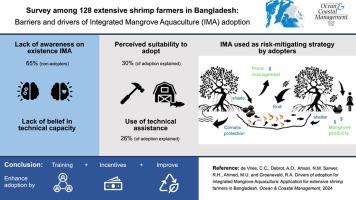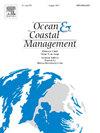Drivers of adoption for integrated mangrove aquaculture: Its application for extensive smallholder shrimp farmers in Bangladesh
IF 4.8
2区 环境科学与生态学
Q1 OCEANOGRAPHY
引用次数: 0
Abstract
Integrated Mangrove Aquaculture (IMA) has the potential to simultaneously address the challenges of environmental degradation arising from conventional shrimp production, the expected impacts of climate change, and the growing global demand for shrimp. These challenges affect coastal livelihoods in Satkhira and Khulna districts of Bangladesh. However, IMA adoption in coastal Bangladesh so far remains low. This study explores the factors that influence IMA adoption by extensive smallholder shrimp farmers in Bangladesh using a questionnaire-based survey of 128 farmers. We identified potential drivers of adoption by combining exploratory data analysis and a logit regression analysis. Key findings were that lack of adoption appeared to be mainly attributed to a lack of awareness of IMA (65% of non-adopters were not aware of the existence of IMA), as well as a lack of trust in own required management skills and technical know-how. On the other hand, positive evaluation of IMA benefits and its main use as a risk mitigating strategy were the main enablers. The logit regression analysis indicated that perceived suitability of the pond to integrate IMA and availability of technical assistance were the factors most important to adoption, explaining respectively 30% and 26% of adoption. To enhance adoption of IMA and reduce the need for new pond excavation in mangrove stands, tailored technical training and social learning opportunities are required to increase awareness of IMA and its potential benefits, as well as for effective IMA management. Additionally, the development of new market opportunities for novel mangrove products is vital to foster incentives for adoption. Further work is needed on how to maximize the potential of IMA by thorough study of its various implementation options.

采用红树林综合水产养殖的驱动因素:在孟加拉国小农虾养殖中的应用
红树林综合水产养殖(IMA)具有同时应对传统对虾生产造成的环境退化、气候变化的预期影响以及全球对虾需求增长等挑战的潜力。这些挑战影响着孟加拉国萨特赫拉和库尔纳地区的沿海生计。然而,迄今为止,IMA 在孟加拉国沿海地区的采用率仍然很低。本研究通过对 128 位养殖户进行问卷调查,探讨了影响孟加拉国小农广泛采用 IMA 的因素。我们结合探索性数据分析和对数回归分析,确定了采用的潜在驱动因素。主要发现是,未采用的主要原因似乎是对 IMA 缺乏认识(65% 的未采用者不知道 IMA 的存在),以及对自身所需的管理技能和技术诀窍缺乏信任。另一方面,积极评价 IMA 的益处及其作为风险缓解战略的主要用途是主要的促进因素。对数回归分析表明,认为池塘适合采用综合管理和技术援助是采用综合管理和技术援助的最重要因素,分别占采用率的 30% 和 26%。为提高 IMA 的采用率并减少在红树林中挖掘新池塘的需求,需要提供有针对性的技术培训和社会学习机会,以提高对 IMA 及其潜在效益的认识,并进行有效的 IMA 管理。此外,为红树林新产品开发新的市场机会对于鼓励采用至关重要。还需要进一步开展工作,通过深入研究各种实施方案,最大限度地发挥 IMA 的潜力。
本文章由计算机程序翻译,如有差异,请以英文原文为准。
求助全文
约1分钟内获得全文
求助全文
来源期刊

Ocean & Coastal Management
环境科学-海洋学
CiteScore
8.50
自引率
15.20%
发文量
321
审稿时长
60 days
期刊介绍:
Ocean & Coastal Management is the leading international journal dedicated to the study of all aspects of ocean and coastal management from the global to local levels.
We publish rigorously peer-reviewed manuscripts from all disciplines, and inter-/trans-disciplinary and co-designed research, but all submissions must make clear the relevance to management and/or governance issues relevant to the sustainable development and conservation of oceans and coasts.
Comparative studies (from sub-national to trans-national cases, and other management / policy arenas) are encouraged, as are studies that critically assess current management practices and governance approaches. Submissions involving robust analysis, development of theory, and improvement of management practice are especially welcome.
 求助内容:
求助内容: 应助结果提醒方式:
应助结果提醒方式:


